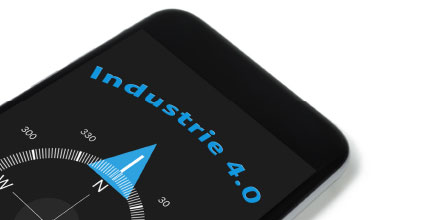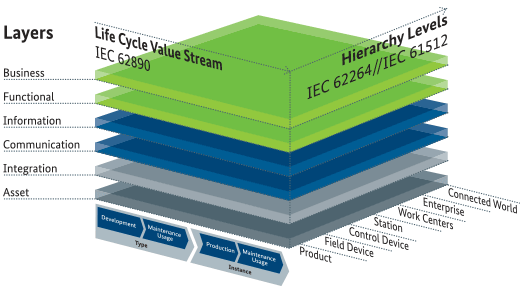- By Bill Lydon
- Automation IT
Summary
Fast Forward
- RAMI 4.0 ensures that all participants involved in Industry 4.0 discussions and activities have a common framework and terminology.
- RAMI 4.0 focused on industrial production as the primary area of application, including discrete manufacturing to process industries.
- The Industry 4.0 movement continues to accelerate defining the pattern for all industrial automation to achieve the goal of holistic and adaptive automation system architectures.

Three-dimensional map showing how to approach Industry 4.0 in a structured manner

The RAMI 4.0, Reference Architecture Model Industrie 4.0 (Industry 4.0), was developed by the German Electrical and Electronic Manufacturers' Association (ZVEI) to support Industry 4.0 initiatives, which are gaining broad acceptance throughout the world. Industry 4.0 (also termed Industrie 4.0) is a holistic view of manufacturing enterprises, started in Germany, with many worldwide cooperative efforts including China, Japan, and India. Industry 4.0 concepts, structure, and methods are being adopted worldwide to modernize manufacturing.
Effective manufacturing
Throughout the world, there is a recognition that to be competitive, manufacturing needs to modernize. The Industry 4.0 movement in particular continues to accelerate defining the pattern of how all industrial automation can achieve the goal of holistic and adaptive automation system architectures. A driving force behind the development of Industry 4.0 is the realization that pursuing low labor rates is not a winning strategy. Remaining competitive and flexible can only be accomplished by leveraging advanced technologies, centering on automation to enable a successful transition. Germany's Industrie 4.0 initiative has ignited cooperative efforts in China, Japan, and India.
Industry 4.0 is interdisciplinary, where the standards applicable in mechanical engineering, electronics, electrical engineering, and communications and information technology need to be combined with the respective technologies needed for their implementation.
Discrete and process industries
The development of RAMI 4.0 focused on industrial production as the primary area of application, including discrete manufacturing to process industries. Industry 4.0 concepts are being applied to process industries to achieve a holistic integration of automation, business information, and manufacturing execution function to improve all aspects of production and commerce across process industry value chains for greater efficiency. The "Process Sensor 4.0 Roadmap" initiated by NAMUR and VDI/VDE, in collaboration with several prominent leaders in the industry (including ABB, BASF, Bayer Technology Services, Bilfinger Maintenance, Endress+Hauser, Evonik, Festo, Krohne, Lanxess, Siemens, and Fraunhofer ICT), reflects the intent of creating fundamental building blocks to advance process automation system architectures. A number of NAMUR working groups are part of Working Area 2 (WA 2), Automation Systems for Processes and Plants.
Related to this activity, the OPC Foundation and FieldComm Group have an initiative to create a protocol-independent, process automation device information model (PA-DIM) specification based on the industrial interoperability standard OPC UA. PROFIBUS/PROFINET International is now participating in this vision, which is supported by NAMUR as part of its Open Architecture (NOA) initiative. The goal is enabling end users to dramatically reduce time to implement advanced analytics, big data projects, and enterprise cloud solutions that rely on information from thousands of geographically dispersed field devices using multiple process automation protocols.

RAMI 4.0 definition
The RAMI 4.0 Reference Architectural Model and the Industry 4.0 components give companies a framework for developing future products and business models. RAMI 4.0 is a three-dimensional map showing how to approach the deployment of Industry 4.0 in a structured manner. A major goal of RAMI 4.0 is to make sure that all participants involved in Industry 4.0 discussions and activities have a common framework to understand each other. The RAMI 4.0 framework is intended to enable standards to be identified to determine whether there is any need for additions and amendments. This model is complemented by the Industry 4.0 components. Both results are described in DIN SPEC 91345 (Reference Architecture Model Industrie 4.0). DIN (www.din.de) represents German interests within the International Organization for Standardization (ISO). Today, roughly 85 percent of all national standard projects are European or international in origin.
Putting the RAMI 4.0 model in perspective, in the glossary of the VDI/VDE-GMA 7.21 Industrie 4.0 technical committee, a reference model is defined as a model that can be generally applied and can be used to derive specific models. There are many examples of this in the field of technology. The most well known is the seven-layer ISO/OSI model, which is used as a reference model for network protocols. The advantage of using such models is a shared understanding of the function of every layer/element and the defined interfaces between the layers.
Important characteristics
RAMI 4.0 defines a service-oriented architecture (SOA) where application components provide services to the other components through a communication protocol over a network. The basic principles of SOA are independent of vendors, products, and technologies. The goal is to break down complex processes into easy-to-grasp packages, including data privacy and information technology (IT) security.
ZVEI characterizes the changing manufacturing systems. The current "Old World Industry 3.0" manufacturing system characteristics are:
- hardware-based structure
- functions bound to hardware
- hierarchy-based communication
- isolated product
The "New World: Industry 4.0" manufacturing system characteristics are:
- flexible systems and machines
- functions distributed throughout the network
- participants interact across hierarchy levels
- communication among all participants
- product part of the network
- RAMI 4.0 structure
RAMI 4.0 consists of a three-dimensional coordinate system that describes all crucial aspects of Industry 4.0. In this way, complex interrelations are broken down into smaller and simpler clusters.
"Hierarchy Levels" axis
On the right horizontal axis are hierarchy levels from IEC 62264, the international standards series for enterprise IT and control systems. These hierarchy levels represent the different functionalities within factories or facilities. (Note that the IEC 62243 standard is based upon ANSI/ISA-95.) To represent the Industry 4.0 environment, these functionalities have been expanded to include work pieces, labeled "Product," and the connection to the Internet of Things and services, labeled "Connected World."
"Life Cycle Value Stream" axis
The left horizontal axis represents the life cycle of facilities and products, based on IEC 62890, Life-cycle management for systems and products, used in industrial-process measurement, control, and automation. Furthermore, a distinction is made between "types" and "instances." A "type" becomes an "instance" when design and prototyping have been completed and the actual product is being manufactured. The model also combines all elements and IT components in the layer and life-cycle model.
"Layers" axis
The six layers on the vertical axis describe the decomposition of a machine into its properties, structured layer by layer, i.e., the virtual mapping of a machine. Such representations originate from information and communication technology, where properties of complex systems are commonly broken down into layers.
Within these three axes, all crucial aspects of Industry 4.0 can be mapped, allowing objects such as machines to be classified according to the model. Highly flexible Industry 4.0 concepts can thus be described and implemented using RAMI 4.0. The model allows for step-by-step migration from the present into the world of Industry 4.0.
Benefits of RAMI 4.0
The model integrates different user perspectives and provides a common way of seeing Industry 4.0 technologies. With RAMI 4.0, requirements of sectors-from manufacturing automation and mechanical engineering to process engineering-can be addressed in industry associations and standardization committees. Thus, RAMI 4.0 brings a common understanding for standards and use cases.
RAMI 4.0 can be regarded as a map of Industry 4.0 solutions. It is an orientation for plotting the requirements of sectors together with national and international standards to define and further develop Industry 4.0. There is a refreshing interest with Industry 4.0 initiatives for various organizations to work cooperatively and overcome the compartmentalization of the national standardization bodies.
The challenge
The influx of technology is starting to dramatically improve manufacturing. However, to do this effectively takes planning, and the RAMI 4.0 model is a focal point for understanding the entire manufacturing and supply chain.
Reader Feedback
We want to hear from you! Please send us your comments and questions about this topic to InTechmagazine@isa.org.


